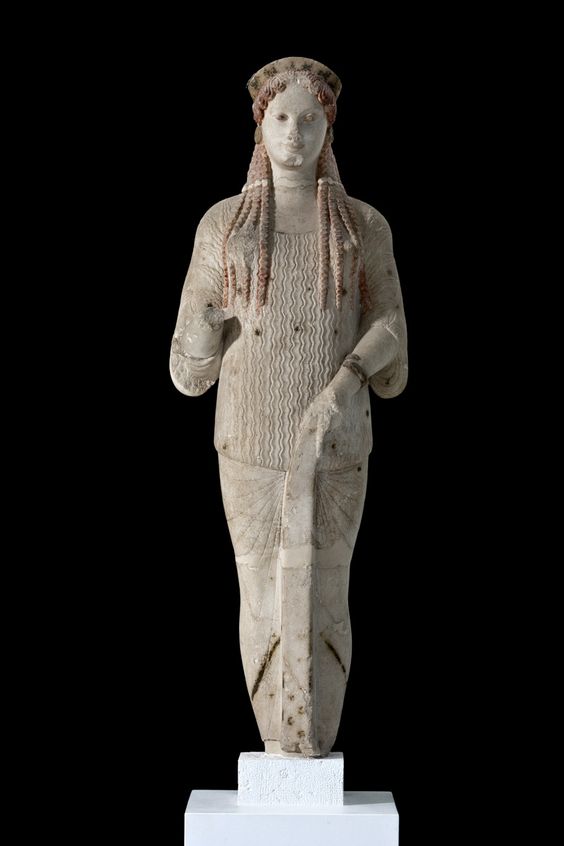Statue of Kore 684 from the Athenian Acropolis

The “Statue of Kore 684” from the Athenian Acropolis is a remarkable example of ancient Greek sculpture, representing both the artistic achievements and cultural values of the period. This statue, dating back to around 520-510 BCE, is one of many korai—sculptures of young women—that were dedicated to the goddess Athena and placed on the Acropolis, the sacred hill overlooking Athens.
The term “Kore” (plural: korai) means “maiden” in Greek, and these statues typically depict young, clothed women standing in a rigid, frontal pose. Kore 684 is a quintessential example of this form, characterized by its intricate detailing and idealized representation of female beauty. Unlike the male kouroi, who are often depicted nude, the korai are always dressed in elaborate garments, which provide valuable insights into the clothing and textile patterns of ancient Greece.

Kore 684 stands at a height of approximately 1.75 meters (about 5 feet 9 inches), a size that allows for a detailed examination of her attire and adornments. She is dressed in a finely draped peplos, a type of garment that hangs in elegant folds, revealing the skill of the sculptor in rendering the softness and movement of the fabric. The peplos is cinched at the waist with a belt, and the careful carving suggests a sense of lightness and fluidity.
One of the most striking features of Kore 684 is her hair, which falls in long, meticulously carved tresses over her shoulders. The stylization of the hair, with its repetitive, almost geometric pattern, contrasts with the naturalistic rendering of the face and body. Her face, with its serene expression and faint, enigmatic smile, is characteristic of the Archaic period’s “Archaic smile,” a feature intended to give the statue a sense of life and vitality.

The statue’s eyes, originally inlaid with precious materials, would have added to this lifelike quality, making Kore 684 not just a religious offering but a vivid representation of an idealized young woman. The details of her jewelry, including earrings and a necklace, further emphasize her status and the wealth of the dedicator, likely a wealthy Athenian family seeking to honor Athena and demonstrate their piety and social standing.
The context in which Kore 684 was found adds another layer of significance to her story. Discovered on the Acropolis, she was part of a larger collection of votive offerings that adorned the sacred site. The Acropolis served as a major religious center in ancient Athens, and the korai were placed there as offerings to Athena, the city’s patron goddess. These statues not only served a religious function but also reflected the artistic and cultural values of the society that created them.

Kore 684, like many other statues on the Acropolis, suffered damage during the Persian invasion of 480 BCE. The invading forces destroyed many of the Acropolis’ structures and artifacts, but the Athenians later buried the damaged sculptures in a ceremonial manner, preserving them for future generations. This act of burial inadvertently protected these artifacts, allowing modern archaeologists to uncover and study them centuries later.
Today, Kore 684 is housed in the Acropolis Museum in Athens, where she continues to be a subject of admiration and scholarly interest. Her well-preserved state offers a window into the past, providing valuable insights into the religious practices, artistic techniques, and social values of ancient Greece.

In conclusion, the “Statue of Kore 684 from the Athenian Acropolis” is not merely an ancient artifact; it is a testament to the enduring legacy of Greek art and culture. Through its beauty, craftsmanship, and historical significance, it remains a poignant reminder of the rich heritage of Athens and the profound reverence the ancient Greeks held for their gods and goddesses.